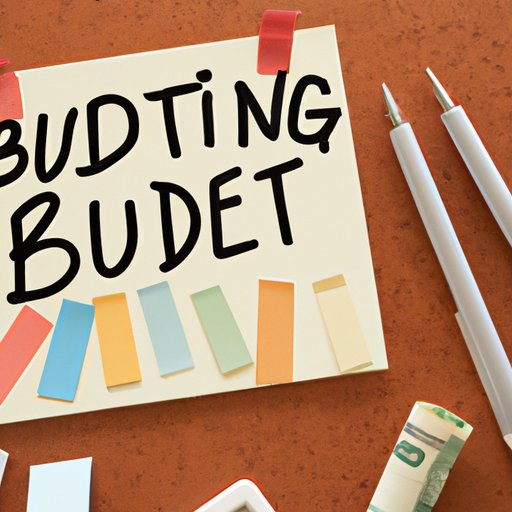Introduction
Saving and investing money can be daunting tasks for many people. With so many options and factors to consider, it can be difficult to know where to start. This article aims to provide a comprehensive guide to saving and investing money, including tips on creating a budget, reducing unnecessary expenses, automating savings, investing in index funds and ETFs, taking advantage of employer-sponsored retirement plans, and considering other types of investments.

Create a Budget and Stick to It
Creating a budget is an essential part of saving and investing money. A budget helps you to track your income and spending, and make sure that you are not spending more than you earn. It also allows you to set aside money for savings and investments. There are several benefits to creating a budget and sticking to it.
The Benefits of Creating a Budget
Creating a budget has numerous benefits, including:
- Helps you to understand your financial situation and identify areas where you can save money.
- Allows you to plan for the future and set goals for saving and investing money.
- Enables you to stay on top of your finances and keep track of your spending.
- Helps you to avoid debt and manage any existing debt more effectively.
Steps to Creating an Effective Budget
Creating an effective budget requires some planning and dedication. Here are some steps to help you get started:
- Calculate your total monthly income.
- Track your expenses for one month.
- Identify areas where you can cut back on spending.
- Set a realistic budget based on your income and expenses.
- Set aside money for savings and investments.
- Review your budget regularly and adjust as necessary.

Cut Down on Unnecessary Expenses
Once you have created a budget, you should focus on reducing unnecessary expenses. This is one of the most important steps in saving and investing money. Identifying and eliminating unnecessary expenses can help you to free up more money for savings and investments.
Identifying Unnecessary Expenses
It can be difficult to identify unnecessary expenses, but it is important to take a close look at your spending habits. Start by tracking your spending for one month and then categorizing your expenses. Once you have done this, you can identify areas where you are spending too much or where you can cut back. Common unnecessary expenses include dining out, entertainment, clothing, and subscriptions.
Ways To Reduce Unnecessary Expenses
Once you have identified areas where you are spending too much, there are several ways to reduce your expenses. Here are some tips to help you save money:
- Set a weekly or monthly spending limit.
- Cancel any unnecessary subscriptions.
- Make a list before shopping and stick to it.
- Look for discounts and coupons.
- Prepare meals at home instead of eating out.
Automate Your Savings
Once you have cut down on unnecessary expenses, you should consider automating your savings. Automating your savings is a great way to ensure that you are setting aside money each month without having to actively think about it. Automating your savings can also help to keep you motivated to save more.
Benefits of Automating Savings
Automating your savings has several benefits, including:
- Helps you to reach your savings goals faster.
- Makes it easier to save money consistently.
- Reduces the temptation to spend money on unnecessary items.
- Allows you to transfer money directly from your paycheck into a savings account.
How to Automate Your Savings
There are several ways to automate your savings. Here are some tips to get you started:
- Set up automatic transfers from your checking to savings account.
- Set up direct deposit to transfer a portion of your paycheck to a savings account.
- Set up automatic payments for bills to ensure that they are paid on time and the money is not spent on other items.
- Take advantage of online tools to help you save money automatically.

Invest in Index Funds or ETFs
Once you have automated your savings, you should consider investing in index funds or ETFs. Index funds and ETFs are low-cost investment vehicles that allow you to invest in a broad range of stocks, bonds, and other securities.
What Are Index Funds and ETFs?
Index funds and ETFs are both types of mutual funds. An index fund is a type of mutual fund that tracks a specific market index, such as the S&P 500. An ETF is a type of mutual fund that trades like a stock. Both index funds and ETFs are low-cost investments that give you access to a wide range of stocks, bonds, and other securities.
Benefits of Investing in Index Funds or ETFs
Investing in index funds or ETFs has several benefits, including:
- Low cost – index funds and ETFs typically have lower fees than other types of investments.
- Diversification – index funds and ETFs allow you to diversify your investments across different markets, sectors, and asset classes.
- Easy to buy and sell – index funds and ETFs can be bought and sold easily through online brokers.
Take Advantage of Employer-Sponsored Retirement Plans
Once you have started investing in index funds or ETFs, you should consider taking advantage of employer-sponsored retirement plans. Employer-sponsored retirement plans are a great way to save for retirement and take advantage of tax benefits.
Types of Retirement Plans
Employer-sponsored retirement plans come in many forms, including 401(k) plans, 403(b) plans, 457 plans, and Roth IRAs. Each type of plan has its own features and benefits, so it is important to research which plan is best for you.
Benefits of Taking Advantage of Employer-Sponsored Retirement Plans
Taking advantage of employer-sponsored retirement plans offers several benefits, including:
- Tax benefits – many employer-sponsored retirement plans offer tax advantages, such as tax-deferred growth and tax-free withdrawals in retirement.
- Employer contributions – many employers match employee contributions to retirement plans, providing an additional incentive to save for retirement.
- Flexibility – most employer-sponsored retirement plans allow you to customize your investments and change your contribution amounts as needed.
Consider Other Types of Investments
Once you have taken advantage of employer-sponsored retirement plans, you should consider diversifying your investments. Diversifying your investments is a great way to spread risk and potentially increase returns. There are several types of investments to consider, including real estate, commodities, and alternative investments.
Real Estate Investing
Real estate investing is a popular way to diversify your investments. Real estate investments can be made in residential or commercial properties. Real estate investments can provide steady cash flow, tax benefits, and potential capital appreciation.
Commodity Investing
Commodity investing is another way to diversify your investments. Commodities are raw materials such as oil, gold, silver, and wheat. Commodity investments can be volatile, but they can also provide potential upside if prices rise.
Benefits of Diversifying Your Investment Portfolio
Diversifying your investment portfolio has several benefits, including:
- Reduces risk – diversifying your investments reduces the risk of losses due to market downturns.
- Potential upside – by investing in different types of investments, you can potentially increase your returns.
- Tax benefits – certain types of investments, such as real estate and commodities, may offer tax benefits.
Conclusion
Saving and investing money can seem like a daunting task, but with some planning and dedication, it can be a rewarding experience. This article provided a comprehensive guide to saving and investing money, including tips on creating a budget, reducing unnecessary expenses, automating savings, investing in index funds and ETFs, taking advantage of employer-sponsored retirement plans, and considering other types of investments. By following these tips, you can create a solid foundation for your financial future.
Summary of Key Points
To recap, here are the key points from this article:
- Create a budget and stick to it.
- Cut down on unnecessary expenses.
- Automate your savings.
- Invest in index funds or ETFs.
- Take advantage of employer-sponsored retirement plans.
- Consider other types of investments.
Final Remarks
By following the tips outlined in this article, you can create a solid foundation for your financial future. Remember to take advantage of all available resources and seek professional advice when necessary. With dedication and planning, saving and investing money can provide a secure financial future.
(Note: Is this article not meeting your expectations? Do you have knowledge or insights to share? Unlock new opportunities and expand your reach by joining our authors team. Click Registration to join us and share your expertise with our readers.)
